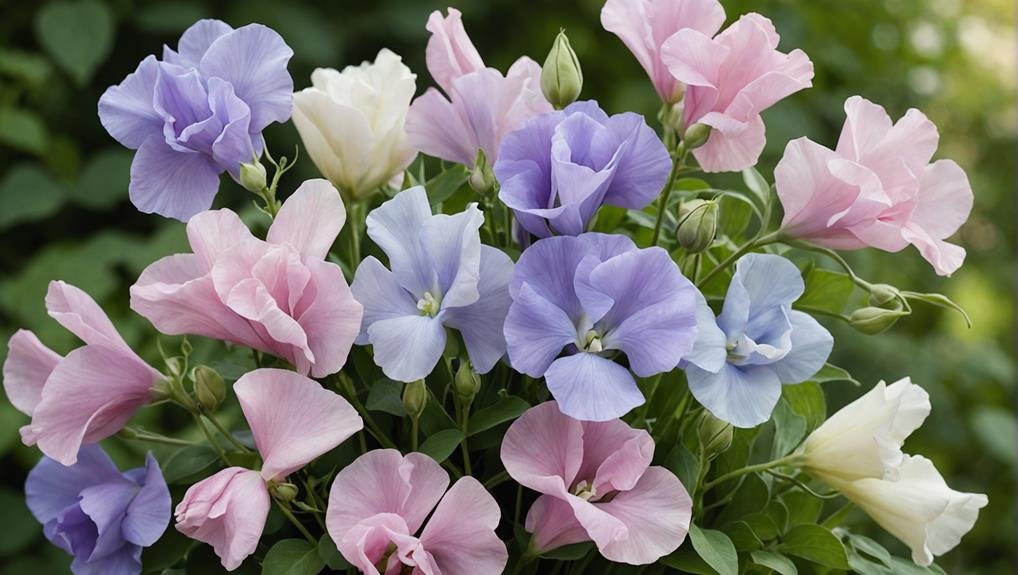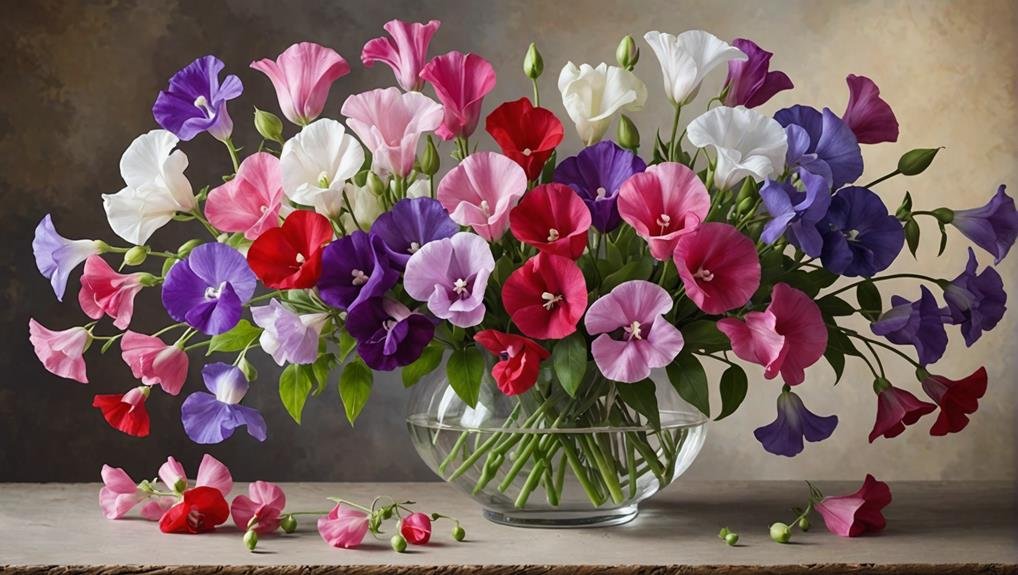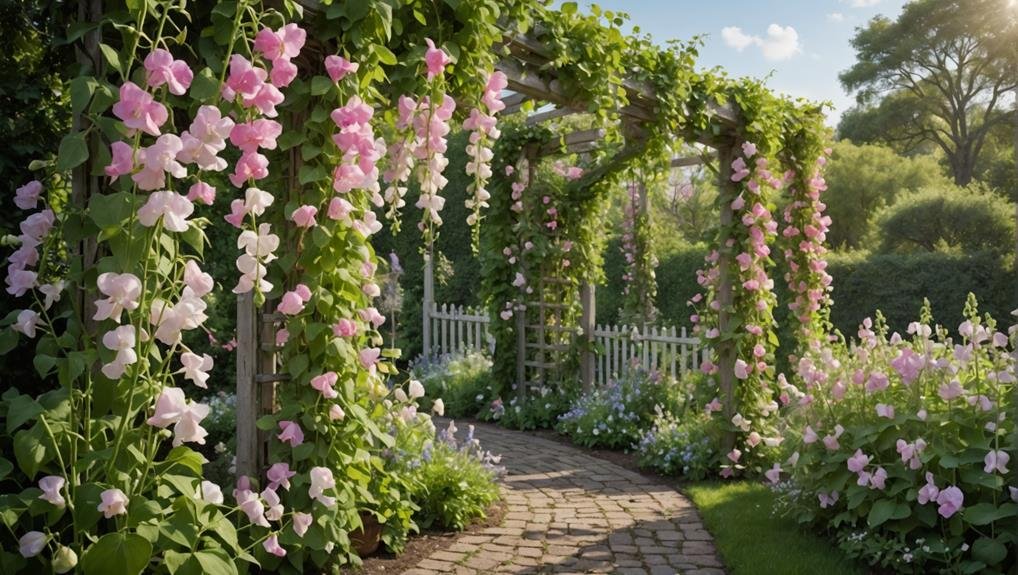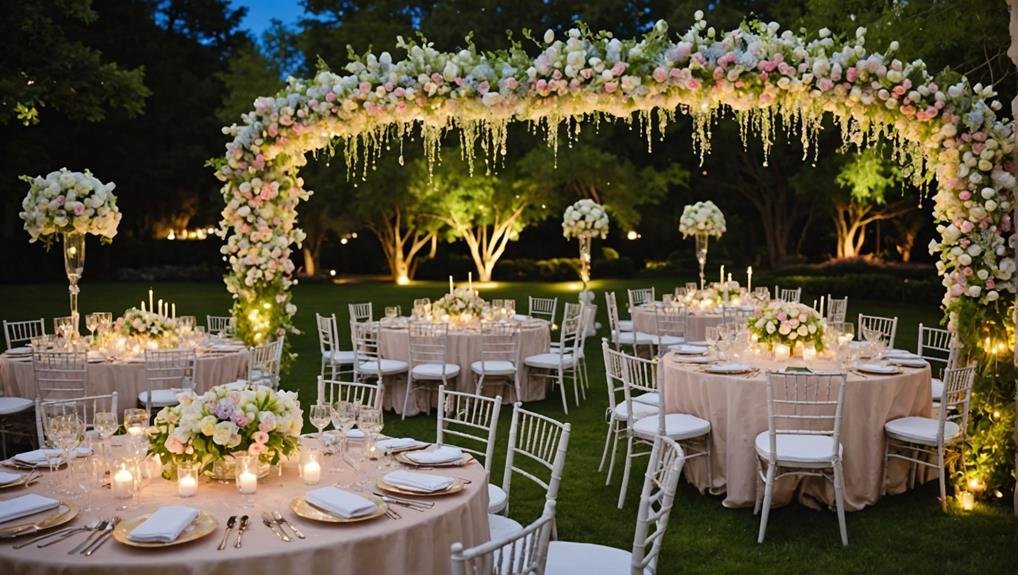When planning a wedding, choosing the appropriate flowers is crucial for establishing the mood and aesthetic of the event. Sweet Peas, renowned for their mesmerizing scent and climbing vine appearance, provide a classic sophistication that has delighted brides and florists alike. Offered in various shades such as pink, white, and purple, these flowers introduce a gentle, romantic element to any display. Their timeless allure and deep cultural importance further enhance their desirability. But what makes Sweet Peas especially interesting for weddings, and how do they stack up against other floral choices in terms of flexibility and meaning?
Flower Overview

Sweet peas, belonging to the Lathyrus odoratus species, are renowned for their enchanting white blooms and sweet fragrance, making them a favored choice for wedding floral arrangements. These flowers epitomize lasting pleasure, gratitude, and delicate pleasures, qualities that resonate deeply in the context of matrimonial celebrations. Their delicate appearance and alluring scent enhance their desirability in the domain of floral design, where they are frequently incorporated into bouquets, centerpieces, and corsages.
In addition to their classic white variety, sweet peas are available in a spectrum of colors, including pink and purple, allowing for versatile and personalized floral designs. This range of hues enables florists to create arrangements that complement various wedding themes and color schemes, ensuring that each event maintains a unique and cohesive aesthetic.
Sweet peas are not only prized for their visual and olfactory appeal but also for their practicality in floral arrangements. With a vase life of 4-6 days, they maintain their beauty throughout wedding festivities. Their ease of cultivation from seed and adaptability to full sun or partial shade make them a reliable choice for both professional florists and home gardeners, further solidifying their standing in the floral design community.
Physical Description
Renowned for their delicate and fragrant nature, these flowers exhibit a vine-like growth habit and come in a diverse palette of colors, including white, pink, and purple. Sweet peas belong to the Lathyrus odoratus species and are celebrated for their charming and elegant appearance, making them a popular choice for wedding bouquets and floral arrangements.
These flowers typically have a stem length ranging from 6 to 16 inches, which makes them ideal cut flowers for various decorative purposes. Their structure allows them to be easily incorporated into cascading arrangements or mixed with other blooms to create a lush, textured effect.
However, due to their vine-like growth habit, sweet peas require support such as trellises or stakes when grown, which helps them to flourish and produce the best quality blooms.
Despite their relatively short vase life of 4-6 days, sweet peas are highly valued for their beauty and enchanting fragrance, which can add a touch of elegance and romance to any wedding setting. Their captivating presence and versatility as cut flowers make them a cherished addition to bridal bouquets, centerpieces, and other wedding floral decorations.
Available Colour Varieties

The diverse color palette of Sweet Peas provides a plethora of options for creating visually stunning and harmonious wedding arrangements. Among the most sought-after varieties, the pink sweet pea stands out for its soft and romantic appeal. This light pink hue is ideal for sophisticated brides aiming to evoke a sense of elegance and tenderness within their floral setups.
White Sweet Peas are another popular choice, offering a classic and timeless look that seamlessly fits into virtually any wedding theme. Their pure and delicate appearance makes them a versatile option, whether used as standalone blossoms or as part of a more intricate bouquet.
For those looking to add depth and richness to their floral arrangements, purple Sweet Peas offer an exceptional choice. Their vibrant and bold color can create striking contrasts or complement other deep-toned flowers, enhancing the overall visual impact of the display.
The availability of these varied color options guarantees that Sweet Peas can be adapted to suit a wide range of wedding aesthetics. From the gentle allure of the pink sweet pea to the classic charm of white and the dramatic flair of purple, these flowers provide endless opportunities for versatile and beautiful floral designs.
Latin Name and Taxonomy
Intriguingly, the Latin name for sweet pea, Lathyrus odoratus, reflects its classification within the Lathyrus genus and the broader Fabaceae family. This nomenclature not only underscores its botanical lineage but also hints at the plant’s aromatic nature, as ‘odoratus’ translates to ‘fragrant.’
Lathyrus odoratus is an annual flowering plant, completing its life cycle within 75-85 days, making it particularly suitable for seasonal wedding decorations.
Belonging to the Lathyrus genus, sweet peas share this classification with a variety of other legumes, emphasizing their familial ties within the Fabaceae family. This family is renowned for its ecological and agricultural significance, including well-known members like beans and peas. Sweet peas, however, are primarily cultivated for their aesthetic appeal rather than their agricultural utility.
Sweet peas are open-pollinated hybrids, which means they can cross-pollinate with other plants, resulting in a diverse range of colors and forms. When fully grown, Lathyrus odoratus can reach impressive heights of 72-96 inches, adding vertical interest to floral arrangements.
This classification and growth habit make sweet peas a versatile and cherished choice for wedding florals, enhancing their allure and desirability among florists and brides alike.
Geographical Origins

Originating from the picturesque regions of Sicily and southern Italy, sweet peas have a rich historical and geographical background that enhances their charm and appeal. These fragrant flowers, known for their vibrant colors and delicate petals, were first introduced to England in the 17th century. Initially, sweet peas were cultivated for their edible peas rather than their ornamental flowers. However, their captivating beauty and scent did not go unnoticed for long.
The Victorian era marked a significant turning point for sweet peas, as their blooms gained widespread popularity among gardeners and floral enthusiasts. This period saw an increased appreciation for their ornamental value, transforming them from a humble garden plant to a sought-after flower in various decorative arrangements.
Today, sweet peas are widely grown and appreciated in gardens and floral designs around the world. Their enchanting fragrance and diverse color palette make them a popular choice for weddings and other special occasions, adding elegance and a touch of historical romance.
| Region | Significance |
|---|---|
| Sicily | Native region, historical cultivation |
| Southern Italy | Native region, historical cultivation |
| England | Introduction in the 17th century |
| Victorian Era | Popularity of sweet pea blooms |
| Global | Widespread cultivation and appreciation |
Season Availability
Sweet peas are mainly in season during the spring and early summer months, making these periods ideal for incorporating their delicate blooms into wedding arrangements. This seasonal availability guarantees that sweet peas are at their freshest and most vibrant, adding a touch of elegance and fragrance to any event.
Understanding the seasonality of sweet peas is essential for planning wedding florals, as their peak bloom times align perfectly with many popular wedding dates.
When considering sweet peas for your wedding, keep in mind the following aspects of their seasonal availability:
- Peak Season: Sweet peas are most abundant from late March to early July, offering a wide selection of colors and varieties during these months.
- Climate Dependency: Availability may vary depending on local climate conditions, with cooler regions possibly extending the blooming period slightly.
- Indoor vs. Outdoor Growth: Sweet peas can be cultivated both outdoors and in indoor containers, providing some flexibility in managing their availability.
- Optimal Freshness: Purchasing sweet peas during their natural blooming season guarantees the highest quality and longevity for your floral arrangements.
Growing Conditions

To guarantee the beauty and health of sweet peas in your wedding arrangements, understanding their growing conditions is crucial. Sweet peas thrive in well-draining soil and need full sun to partial shade to flourish. These conditions are particularly important for the wide range of sweet pea varieties available, each offering unique colors and fragrances that can enhance any wedding setting.
Sweet peas can grow up to 72-96 inches in height, making them ideal for trellises or garden borders. This vertical growth not only adds a striking visual element but also maximizes the use of garden space. Proper protection from strong winds is essential to prevent damage to their delicate stems.
Sweet peas are known to attract pollinators like bees and butterflies, which can contribute to a vibrant garden ecosystem. Watering and fertilization are key to ensuring the best possible growth. Regular watering should keep the soil consistently moist but not waterlogged.
Sweet peas are relatively easy to grow from seed, making them accessible for gardeners in various climates. With the correct growing conditions, sweet pea varieties will bring both fragrance and elegance to your wedding arrangements, creating a memorable and beautiful atmosphere.
Cultural Significance
In the language of flowers, sweet peas carry the profound meanings of lasting pleasure and delicate joy, making them a beloved choice for wedding arrangements. These charming blossoms have been celebrated for their cultural significance throughout history and across various traditions.
The name ‘sweet pea’ originates from the Greek word ‘lathyros,’ meaning pulse or pea, and the Latin word ‘odoratus,’ meaning fragrant, indicating their pleasant scent and historical roots.
Sweet peas gained notable recognition after being associated with the royal wedding of Prince Harry and Meghan Markle in 2018, further cementing their status as symbols of elegance and refined beauty. Their beautiful white blooms, often accompanied by soft hues of pink and purple, add a touch of grace and sophistication to any setting.
To highlight their cultural importance, consider the following key points:
- Symbolism: They represent lasting pleasure and delicate joy, making them ideal for romantic and celebratory occasions.
- Historical Roots: The name is derived from Greek and Latin, reflecting their long-standing presence in floral traditions.
- Royal Endorsement: Their association with royal weddings adds to their prestige and allure.
- Variety: Available in multiple colors, they offer versatility in floral designs.
Sweet peas’ cultural significance and timeless beauty make them a cherished addition to wedding celebrations.
Typical Use in Weddings

Often featured in bridal bouquets, centerpieces, corsages, and boutonnieres, sweet peas add a romantic and elegant touch to wedding decor with their delicate and fragrant blooms. These flowers are highly valued for their symbolism of lasting pleasure, gratitude, and delicate pleasures, making them an ideal choice for wedding celebrations. The versatility in color options, including white, pink, and purple, allows them to seamlessly blend into various wedding themes and palettes.
Sweet peas are particularly favored in bridal bouquets due to their soft and feminine aesthetic, which lends an air of romance to the bride’s overall look. Their gentle fragrance and delicate petals create an enchanting atmosphere, perfect for a wedding setting. Additionally, sweet peas can be used sweetly in centerpieces where their beauty can be showcased on reception tables, enhancing the visual appeal of the venue.
To illustrate their versatility in wedding arrangements, consider the following table showcasing the typical uses of sweet peas in various wedding elements:
| Wedding Element | Use Sweet Pea For | Benefit |
|---|---|---|
| Bridal Bouquets | Soft, feminine aesthetic | Romantic look |
| Centerpieces | Fragrant, delicate appeal | Enhances venue ambiance |
| Corsages | Elegant, understated accessory | Complements bridal party’s attire |
Their ability to add a touch of elegance and romance makes sweet peas a consistently popular choice in wedding floristry.
Alternative Flower Types
Exploring different flower types for wedding arrangements can introduce a diverse range of textures, colors, and forms to enhance the overall aesthetic of the event. When considering replacements for sweet peas, several options can provide equally beautiful and versatile choices for bouquets and decor.
- Roses, Peonies, Tulips, and Ranunculus: These flowers offer a variety of shapes and colors that can easily complement any wedding theme. Their timeless beauty and grace make them ideal for various arrangements.
- Lilies, Hydrangeas, Dahlias, and Orchids: These blooms are popular choices for their striking appearance and ability to create a lush, vibrant look in wedding bouquets.
- Sunflowers, Daisies, Carnations, and Chrysanthemums: For those seeking lively and budget-friendly options, these flowers provide excellent substitutions that do not compromise on visual appeal.
- Gerbera Daisies, Anemones, Calla Lilies, and Freesias: These flowers can serve as charming alternatives to sweet peas, bringing unique forms and colors to bridal arrangements.
Additionally, incorporating elements like lavender, baby’s breath, eucalyptus, and succulents can add unique textures and fragrances to wedding decor. These versatile replacements guarantee that each floral arrangement remains enchanting and memorable.
